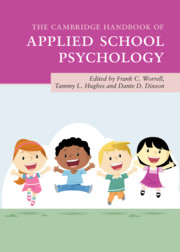Book contents
- The Cambridge Handbook of Applied School Psychology
- The Cambridge Handbook of Applied School Psychology
- Copyright page
- Contents
- Contributors
- Contributor Biographies
- Acknowledgments
- 1 Broadening the Focus of School Psychology Practice
- Part I Individual-Level Academic Interventions
- Part II Teacher- and System-Level Interventions
- Part III Interventions from Educational and Social/Personality Psychology
- Part IV Behavioral and Social-Emotional Interventions
- 19 Internalizing Problems and Disorders of Childhood
- 20 Adolescent Suicidal Behavior in Schools: What to Know and What to Do
- 21 Emotional Disturbance versus Social Maladjustment
- 22 Autism Spectrum Disorder and Illegal Acts
- 23 Effective Bullying Prevention and Intervention Strategies for School Professionals
- 24 Principles of Prevention and Intervention to Close Discipline Gaps in Schools
- 25 Social and Emotional Learning in Schools
- Part V Health and Pediatric Interventions
- Part VI Family Connections and Life Transitions
- Part VII Special Populations
- Part VIII Conclusion
- Index
- References
24 - Principles of Prevention and Intervention to Close Discipline Gaps in Schools
from Part IV - Behavioral and Social-Emotional Interventions
Published online by Cambridge University Press: 18 September 2020
- The Cambridge Handbook of Applied School Psychology
- The Cambridge Handbook of Applied School Psychology
- Copyright page
- Contents
- Contributors
- Contributor Biographies
- Acknowledgments
- 1 Broadening the Focus of School Psychology Practice
- Part I Individual-Level Academic Interventions
- Part II Teacher- and System-Level Interventions
- Part III Interventions from Educational and Social/Personality Psychology
- Part IV Behavioral and Social-Emotional Interventions
- 19 Internalizing Problems and Disorders of Childhood
- 20 Adolescent Suicidal Behavior in Schools: What to Know and What to Do
- 21 Emotional Disturbance versus Social Maladjustment
- 22 Autism Spectrum Disorder and Illegal Acts
- 23 Effective Bullying Prevention and Intervention Strategies for School Professionals
- 24 Principles of Prevention and Intervention to Close Discipline Gaps in Schools
- 25 Social and Emotional Learning in Schools
- Part V Health and Pediatric Interventions
- Part VI Family Connections and Life Transitions
- Part VII Special Populations
- Part VIII Conclusion
- Index
- References
Summary
Educators and school psychologists are seeking ways to eliminate race and gender disparities in their school discipline. This chapter offers the Framework for Increasing Equity in School Discipline to guide their efforts in reforming discipline policy and practices. The principles are comprehensive, with an emphasis on both prevention and intervention. They identify the characteristics of classrooms and schools that need to be strengthened to prevent disciplinary interactions. With regard to intervention, they call for student and adult development of social and behavioral skills, equitable access to adult support, and a problem-solving approach to conflict that integrates family and student voice. Together, the principles show promise for reducing the use of exclusionary discipline and the punitive treatment of marginalized students.
Keywords
- Type
- Chapter
- Information
- The Cambridge Handbook of Applied School Psychology , pp. 409 - 427Publisher: Cambridge University PressPrint publication year: 2020



